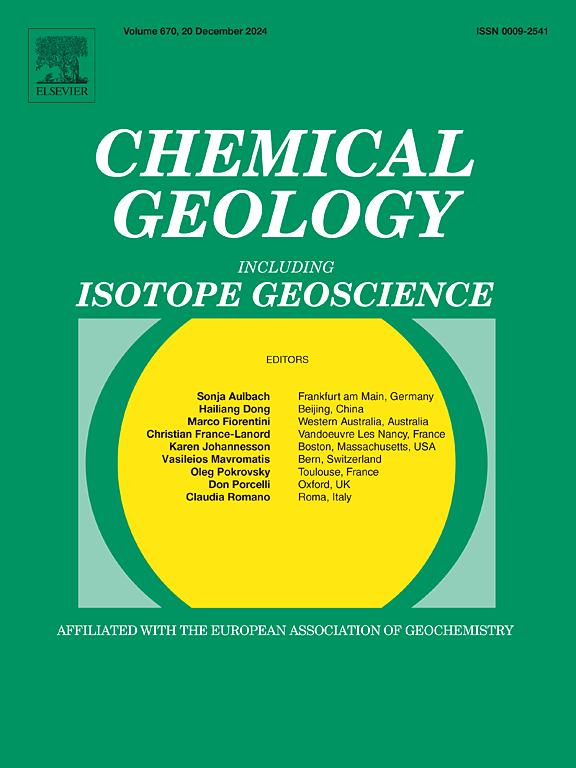Probing chemical transport through a rock using a porphyroblast population: Insights from the distributions of major, minor, and trace elements in garnet from the Danba dome (SW China)
IF 3.6
2区 地球科学
Q1 GEOCHEMISTRY & GEOPHYSICS
引用次数: 0
Abstract
A population of garnet porphyroblasts, spaced apart between c. 6 mm and 40 mm, in a metapelite of the kyanite zone from the Danba dome was investigated to assess the equilibration length scales of major and trace elements in the intergranular medium during garnet crystallization. Garnet crystallization occurred from ∼525 °C / ∼6.2 kbar to peak conditions of ∼635 °C / ∼6.2–7.7 kbar. Enrichments in the concentrations of Fe, Nb, Cr, and V, as well as depletions in the contents of Ca, Li, Na, Y, and heavy rare earth elements (HREE) in the early-grown garnet portions indicate that garnet initially pseudomorphed biotite. Results of the statistical analysis of the garnet 3D distribution suggest clustering nucleation mechanisms, providing textural evidence of spatial variations in the distributions of energetically favourable nucleation sites early in the garnet crystallization history. With the exception of the core domains of two early-grown crystals (SC1 and SC8), the distributions of Mg, Ca, Mn, and Fe reflect growth zoning of a garnet population, overprinted by intracrystalline diffusion. The concentrations of Li, Na, Sc, Y, Dy, and Ho in simultaneously grown segments of all garnet crystals are quantitatively comparable, suggesting that the intergranular medium can be considered compositionally homogeneous with regards to these elements, indicative of rapid intergranular chemical transport over a distance of at least c. 40 mm. Differences in the concentrations of Er, Tm, Yb, and Lu are only observed in crystals more than c. 12 mm apart, with the concentrations of these elements decreasing as their atomic masses increase. This systematic trend is interpreted to reflect the possible influence of the relative atomic masses of these elements on the length scales of their diffusion through the intergranular medium during garnet growth. Elements that were heterogeneously distributed across the intergranular medium at the mm-scale during garnet growth include Cr and Zr, reflecting the compositional heterogeneity of the protolith, preserved due to the negligible transport of these elements during the metamorphism. This study emphasizes that the equilibration length scales of trace elements during metamorphism may be larger than previously assumed, presumably depending on the duration of the metamorphism.
利用卟啉母细胞群探测岩石中的化学运输:来自丹巴圆丘石榴石中主要、次要和微量元素分布的启示
摘要研究了丹巴圆丘蓝晶石带中石榴石卟绿母细胞群的分布,研究了石榴石结晶过程中晶间介质中主微量元素的平衡长度尺度。石榴石结晶发生在~ 525°C / ~ 6.2 kbar至~ 635°C / ~ 6.2 - 7.7 kbar的峰值条件。早期生长的石榴石部分Fe、Nb、Cr和V的富集以及Ca、Li、Na、Y和重稀土元素(HREE)的缺失表明,石榴石最初是假晶黑云母。对石榴石三维分布的统计分析结果表明,集群成核机制,为石榴石结晶历史早期能量有利成核位点分布的空间变化提供了纹理证据。除了两个早期生长晶体(SC1和SC8)的核心区域外,Mg、Ca、Mn和Fe的分布反映了石榴石种群的生长分区,由晶内扩散覆盖。在所有石榴石晶体同时生长的片段中,Li、Na、Sc、Y、Dy和Ho的浓度在数量上具有可比性,这表明在这些元素的组成上,晶间介质可以被认为是均匀的,表明在至少c. 40 mm的距离上,快速的晶间化学传输。Er, Tm, Yb和Lu的浓度差异只在间距大于c. 12 mm的晶体中观察到,这些元素的浓度随着原子质量的增加而降低。这种系统的趋势被解释为反映了这些元素的相对原子质量对它们在石榴石生长过程中通过晶间介质扩散的长度尺度的可能影响。在石榴石生长过程中,在毫米尺度上均匀分布在晶间介质中的元素包括Cr和Zr,反映了原岩的组成不均匀性,由于这些元素在变质作用期间的迁移可以忽略不计,因此被保存下来。本研究强调,变质作用过程中微量元素的平衡长度尺度可能比以前假设的要大,这可能取决于变质作用的持续时间。
本文章由计算机程序翻译,如有差异,请以英文原文为准。
求助全文
约1分钟内获得全文
求助全文
来源期刊

Chemical Geology
地学-地球化学与地球物理
CiteScore
7.20
自引率
10.30%
发文量
374
审稿时长
3.6 months
期刊介绍:
Chemical Geology is an international journal that publishes original research papers on isotopic and elemental geochemistry, geochronology and cosmochemistry.
The Journal focuses on chemical processes in igneous, metamorphic, and sedimentary petrology, low- and high-temperature aqueous solutions, biogeochemistry, the environment and cosmochemistry.
Papers that are field, experimentally, or computationally based are appropriate if they are of broad international interest. The Journal generally does not publish papers that are primarily of regional or local interest, or which are primarily focused on remediation and applied geochemistry.
The Journal also welcomes innovative papers dealing with significant analytical advances that are of wide interest in the community and extend significantly beyond the scope of what would be included in the methods section of a standard research paper.
 求助内容:
求助内容: 应助结果提醒方式:
应助结果提醒方式:


